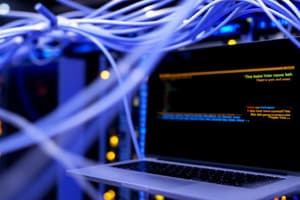Podcast
Questions and Answers
Which type of network is designed to connect devices over an entire city or large campus?
Which type of network is designed to connect devices over an entire city or large campus?
- LAN
- PAN
- WAN
- MAN (correct)
What is the main purpose of a router in a network?
What is the main purpose of a router in a network?
- To monitor incoming and outgoing traffic
- To convert digital data to analog
- To connect devices within a LAN
- To connect different networks and direct data traffic (correct)
What characterizes the 'star' topology in networking?
What characterizes the 'star' topology in networking?
- Devices share a single communication line
- Devices connect directly to each other
- Each device connects in a circular format
- All devices connect to a central hub or switch (correct)
What is the main function of a firewall in network security?
What is the main function of a firewall in network security?
Which of the following statements is true about IPv6?
Which of the following statements is true about IPv6?
What does latency refer to in data transmission?
What does latency refer to in data transmission?
Which protocol ensures reliable delivery of data packets?
Which protocol ensures reliable delivery of data packets?
What is the primary advantage of using a VPN?
What is the primary advantage of using a VPN?
Flashcards are hidden until you start studying
Study Notes
Networking Principles
-
Definition of Networking:
- The practice of connecting computers and other devices to share resources and information.
-
Types of Networks:
- LAN (Local Area Network): Covers a small geographic area, such as a home or office.
- WAN (Wide Area Network): Spans a large geographic area, often connecting multiple LANs.
- MAN (Metropolitan Area Network): Covers a city or a large campus.
- PAN (Personal Area Network): A small network, typically within a single room, connecting personal devices.
-
Network Topologies:
- Bus: All devices share a single communication line.
- Star: All devices connect to a central hub or switch.
- Ring: Each device is connected in a circular format.
- Mesh: Every device connects to multiple other devices for redundancy.
-
Network Devices:
- Router: Connects different networks and directs data traffic.
- Switch: Connects devices within a LAN, forwarding data to the correct device.
- Hub: A basic device that connects multiple Ethernet devices in a LAN.
- Modem: Converts digital data from a computer to analog for transmission over phone lines and vice versa.
-
IP Addressing:
- IPv4: 32-bit address format, consisting of four octets (e.g., 192.168.1.1).
- IPv6: 128-bit address format, designed to replace IPv4 due to the exhaustion of available addresses.
-
Protocols:
- TCP (Transmission Control Protocol): Ensures reliable delivery of data packets.
- UDP (User Datagram Protocol): Offers faster, but less reliable transmission.
- HTTP/HTTPS (Hypertext Transfer Protocol/Secure): Protocols for transferring web pages.
- FTP (File Transfer Protocol): Protocol for transferring files between computers.
-
Network Security:
- Firewalls: Devices or software that monitor and control incoming and outgoing network traffic.
- VPN (Virtual Private Network): Creates a secure connection over the internet, allowing remote users to access a private network.
- Encryption: Protects data by converting it into a secure format during transmission.
-
Data Transmission:
- Bandwidth: The maximum rate of data transfer across a network.
- Latency: The time taken for data to travel from source to destination.
- Packet Switching: Method of grouping data into packets for efficient transmission.
-
Wireless Networking:
- Wi-Fi: A technology that allows devices to connect to a network wirelessly.
- Bluetooth: A short-range wireless technology for connecting devices.
-
Networking Models:
- OSI Model: A conceptual framework with seven layers (Application, Presentation, Session, Transport, Network, Data Link, Physical).
- TCP/IP Model: A four-layer model (Application, Transport, Internet, Network Interface) used for internet communication.
Networking Principles
- Networking: A practice that facilitates the connection of computers and devices for sharing resources and information.
Types of Networks
- LAN (Local Area Network): A small network covering limited areas like homes or offices.
- WAN (Wide Area Network): A large network that spans multiple cities or countries, connecting several LANs.
- MAN (Metropolitan Area Network): A network designed for a specific geographic area, such as a city or large campus.
- PAN (Personal Area Network): A very small network, typically within a single room, linking personal devices like smartphones and tablets.
Network Topologies
- Bus: All devices share a single communication line, which can lead to collisions and slowdowns.
- Star: All devices connect to a central hub or switch, improving reliability as a single point of failure does not affect the whole network.
- Ring: Each device connects to two others, forming a circular pathway for data which can have delays if a device fails.
- Mesh: Every device connects to multiple others, enhancing redundancy and reliability in data transmission.
Network Devices
- Router: Directs data traffic between different networks, ensuring efficient data flow.
- Switch: Connects devices within a LAN, intelligently forwarding data packets to the correct device.
- Hub: A basic networking device that connects multiple Ethernet devices; less efficient as it broadcasts data to all ports.
- Modem: Converts digital signals from a computer to analog for transmission over phone lines, and vice versa.
IP Addressing
- IPv4: Utilizes a 32-bit address format composed of four octets (e.g., 192.168.1.1), currently the most widely used addressing scheme.
- IPv6: A 128-bit address format developed to address the limitations and exhaustion of IPv4 addresses.
Protocols
- TCP (Transmission Control Protocol): Guarantees reliable data delivery by establishing a connection prior to data transmission.
- UDP (User Datagram Protocol): Transmits data more quickly but without guarantees for delivery or order.
- HTTP/HTTPS: Protocols used for transferring web pages; HTTPS provides a secure version.
- FTP (File Transfer Protocol): Allows file transfers between computers over the network.
Network Security
- Firewalls: Hardware or software systems that monitor and filter network traffic based on security rules.
- VPN (Virtual Private Network): Establishes a secure connection over the internet for remote users to access private networks safely.
- Encryption: Converts data into a secure format to protect its integrity during transmission.
Data Transmission
- Bandwidth: Represents the maximum data transfer rate across a network, crucial for performance assessment.
- Latency: Refers to the delay before a transfer of data begins following an instruction.
- Packet Switching: Efficient method of transmitting data by breaking it into packets that travel through various routes.
Wireless Networking
- Wi-Fi: Allows devices to connect to a local network without physical cables, offering flexibility and mobility.
- Bluetooth: A short-range wireless technology commonly used for connecting devices such as headsets and keyboards.
Networking Models
- OSI Model: A conceptual framework consisting of seven layers (Application, Presentation, Session, Transport, Network, Data Link, Physical) used to understand and implement network interactions.
- TCP/IP Model: A four-layer framework (Application, Transport, Internet, Network Interface) that underpins internet communications, focusing on efficient data transfer.
Studying That Suits You
Use AI to generate personalized quizzes and flashcards to suit your learning preferences.




